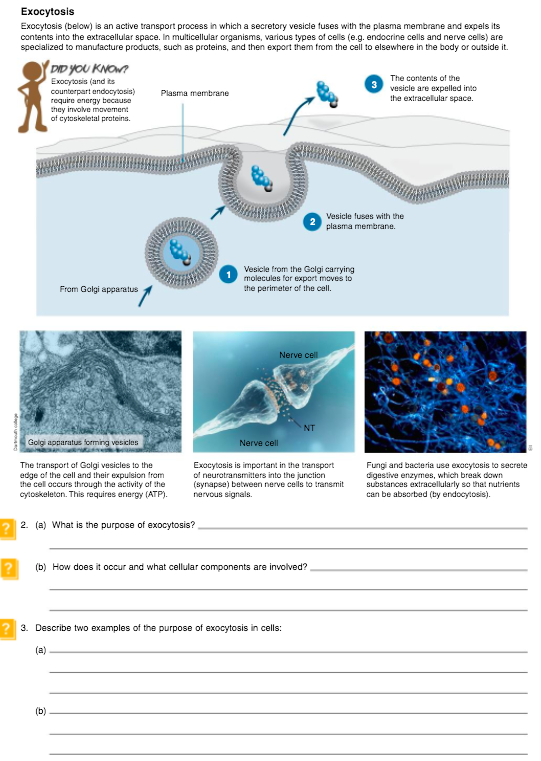Exocytosis Exocytosis (below) is an active transport process in which a secretory vesicle fuses with the plasma membrane and expels its contents into the extracellular space. In multicellular organisms, various types of cells (e.g. endocrine cells and nerve cells) are specialized to manufacture products, such as proteins, and then export them from the cell to elsewhere in the body or outside it. (DID YOU KNOW? The contents of the Exocytosis (and its counterpart endocytosis) require energy because they involve maverment of cytoskeletal proteins. vesicle are expelled into the extracellular space. Plasma membrane Vesicle fuses with the plasma membrane. Vesicle from the Golgi carrying molecules for export moves to the perimeter of the cell. From Golgi apparatus Nerve cell NT Golgi apparatus forming vesicles Nerve cell The transport of Golgi vesicles to the edge of the cell and their expulsion from the cell occurs through the activity of the cyloskeleton. This requires energy (ATP). Exocytosis is important in the transport of neurotransmitters into the junction (synapse) between nerve cels to transmit nervous signals. Fungi and bacteria use exocytosis to secrete digestive enzymes, which break down substances extracellularly so that nutrients can be absorbed (by endocytosis). 2. (a) What is the purpose of exocytosis? (b) How does it occur and what cellular components are involved? ? 3. Describe two examples of the purpose of exocytosis in cells: (a) (b)
Exocytosis Exocytosis (below) is an active transport process in which a secretory vesicle fuses with the plasma membrane and expels its contents into the extracellular space. In multicellular organisms, various types of cells (e.g. endocrine cells and nerve cells) are specialized to manufacture products, such as proteins, and then export them from the cell to elsewhere in the body or outside it. (DID YOU KNOW? The contents of the Exocytosis (and its counterpart endocytosis) require energy because they involve maverment of cytoskeletal proteins. vesicle are expelled into the extracellular space. Plasma membrane Vesicle fuses with the plasma membrane. Vesicle from the Golgi carrying molecules for export moves to the perimeter of the cell. From Golgi apparatus Nerve cell NT Golgi apparatus forming vesicles Nerve cell The transport of Golgi vesicles to the edge of the cell and their expulsion from the cell occurs through the activity of the cyloskeleton. This requires energy (ATP). Exocytosis is important in the transport of neurotransmitters into the junction (synapse) between nerve cels to transmit nervous signals. Fungi and bacteria use exocytosis to secrete digestive enzymes, which break down substances extracellularly so that nutrients can be absorbed (by endocytosis). 2. (a) What is the purpose of exocytosis? (b) How does it occur and what cellular components are involved? ? 3. Describe two examples of the purpose of exocytosis in cells: (a) (b)
Human Physiology: From Cells to Systems (MindTap Course List)
9th Edition
ISBN:9781285866932
Author:Lauralee Sherwood
Publisher:Lauralee Sherwood
Chapter3: The Plasma Membrane And Membrane Potential
Section: Chapter Questions
Problem 1TAHL: Which of the following methods of transport is being used to transfer the substance into the cell in...
Related questions
Question

Transcribed Image Text:Exocytosis
Exocytosis (below) is an active transport process in which a secretory vesicle fuses with the plasma membrane and expels its
contents into the extracellular space. In multicellular organisms, various types of cells (e.g. endocrine cells and nerve cells) are
specialized to manufacture products, such as proteins, and then export them from the cell to elsewhere in the body or outside it.
(DID YOU KNOW?
The contents of the
Exocytosis (and its
counterpart endocytosis)
require energy because
they involve maverment
of cytoskeletal proteins.
vesicle are expelled into
the extracellular space.
Plasma membrane
Vesicle fuses with the
plasma membrane.
Vesicle from the Golgi carrying
molecules for export moves to
the perimeter of the cell.
From Golgi apparatus
Nerve cell
NT
Golgi apparatus forming vesicles
Nerve cell
The transport of Golgi vesicles to the
edge of the cell and their expulsion from
the cell occurs through the activity of the
cyloskeleton. This requires energy (ATP).
Exocytosis is important in the transport
of neurotransmitters into the junction
(synapse) between nerve cels to transmit
nervous signals.
Fungi and bacteria use exocytosis to secrete
digestive enzymes, which break down
substances extracellularly so that nutrients
can be absorbed (by endocytosis).
2. (a) What is the purpose of exocytosis?
(b) How does it occur and what cellular components are involved?
? 3. Describe two examples of the purpose of exocytosis in cells:
(a)
(b)
Expert Solution
This question has been solved!
Explore an expertly crafted, step-by-step solution for a thorough understanding of key concepts.
This is a popular solution!
Trending now
This is a popular solution!
Step by step
Solved in 3 steps

Recommended textbooks for you

Human Physiology: From Cells to Systems (MindTap …
Biology
ISBN:
9781285866932
Author:
Lauralee Sherwood
Publisher:
Cengage Learning

Concepts of Biology
Biology
ISBN:
9781938168116
Author:
Samantha Fowler, Rebecca Roush, James Wise
Publisher:
OpenStax College

Human Physiology: From Cells to Systems (MindTap …
Biology
ISBN:
9781285866932
Author:
Lauralee Sherwood
Publisher:
Cengage Learning

Concepts of Biology
Biology
ISBN:
9781938168116
Author:
Samantha Fowler, Rebecca Roush, James Wise
Publisher:
OpenStax College